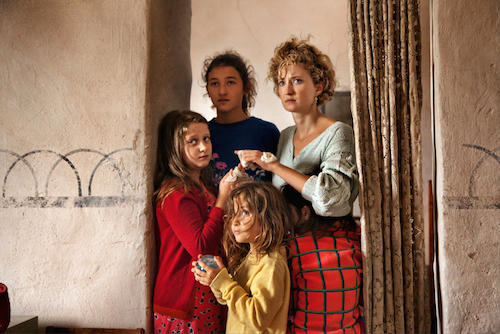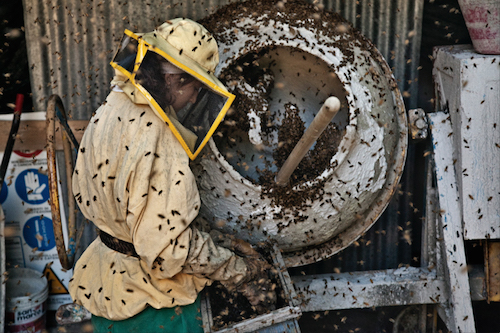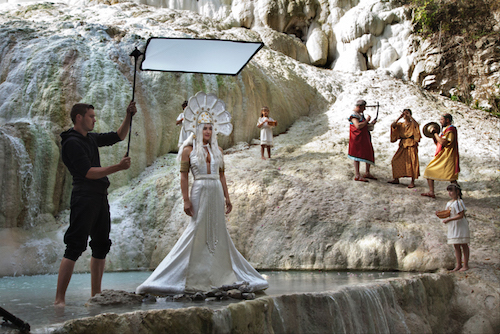- 9 years ago
-
I once read that people who see faces in inanimate, non-portrait objects, are neurotic, and the article did not mean that endearingly. If that’s true, then children who make animal and human shapes out of clouds (so many) are neurotic. And truthfully, most artists are too. So with that, I will use this post to talk about an artists who plays with this idea in a rather beautiful way, and to tip my hat to those individuals who choose to and are able to view the world in a more fascinating way.
Jane Lafarge Hamill‘s paintings combine traditional portraiture with modern abstraction. Her works first appear as a slather of saturated, vibrant colors, enhanced by her thick application of paint. However, though appearing haphazard, the way she has manipulated the paint allows for a vague, albeit familiar, image of a human’s face to come through. Depending on how she has arranged the lines sometimes the face is in profile, sometimes face front.
What really allows for the portraits to be visualized is not in the revelation of facial features, as they are pretty blurry, but in the way the lines make up the shape of the head – the forehead, jawline, and neck specifically. While this alone makes her painting style unique, what makes her work beautiful is her use of color. Her pieces are not exceptionally large, rather they are on the smaller side, yet they instantly pop out due to the layers of applied color and the vibrancy of the palette.
What is especially contemporary about her paintings is the ambiguity of gender in the portraits. I would be interested to hear who sees what gender, if at all, in the works. It allows for individual readings. Some of the best art I’ve seen recently leaves interpretation open to the viewer rather than forcing them to see something preconceived. This ultimately fosters a deeper personal connection for the viewer to her paintings, and therefore doesn’t distance art from the mass public.
All in all Jane Lafarge Hamill’s works are complicated in technique but approachable in her romantic brushstrokes, color. Her dedication to the craft of painting has allowed her works to retain a modernist, contemporary spirit of narrowing the gap between viewer and artwork.
Latest News
- 9 years ago
-
NYC Arts Non Profit Heads West in Support of Local Arts Programs
Convergence: Saturday, November 14th, Studio Maesto, Santa Monica, CA.On Saturday, November 14th New York City based non-profit Art for Progress (AFP) will host a fundraiser in support of Studio Maesto’s Arts Collective Program in Santa Monica, California. The event will take place at Studio Maesto’s dance and photography studio at 1547 6th Street, Santa Monica, and will feature visual art from three Los Angeles based artists who have exhibited with AFP in the past- Sona Mirzaei, Lichiban and Pablo Damas. The night will also showcase live performances from Barry Komitor (NYC based band Bad Faces), DJ sets from NYC’s Gatto, LA based DJ/Producer Elliot DeHoyos and a myriad of local performance artists. Net proceeds from ticket sales and a percentage of art sales will go to support the studios arts collective program (details below). Tickets ($15) will be available at the door. Tickets include a drink and light fare. Additional beverages will be available for purchase. Studio Maesto, 1547 6th Street, Santa Monica, CA – Hours: 7:30pm – 11:00pm
Over the last 12 years, Art for Progress has produced over 50 major events in NYC, Miami, San Francisco and Washington DC. With a focus on multimedia productions, AFP has garnered valuable press coverage for artists in world renowned publications such as The New York Times, Women’s Wear Daily and The Village Voice. While supporting and promoting artists through these events, the events also raise funds for AFP’s art programs in the NYC Public Schools.
Maesto Arts Collective is a program dedicated to providing free dance, photography, and art workshops for children who do not have access to art programs and aiding and sponsoring artists by providing a “creative home” where they can teach, learn new skills, and share their talents with the community.
Art for Progress
“Creative Culture Accelerating Social Change”
- 9 years ago
-
Los Angeles-based Knative Clothing, helmed by Ariel Goodman-Weston produces “fully fashioned knitwear” that’s not only environmentally conscious, but is also waste conscious.
Fashion-making typically begets a lot of waste—from discarded textiles to water use. Finding a brand that truly tries to incorporate “no-waste” techniques is definitely something worth calling attention to. It’s also important to distinguish these fashion labels from fast-fashion brands like H&M that attempt to present themselves as eco-conscious in a dishonest practice referred to as greenwashing.
Brands like Knative Clothing create handmade, durable products. And because of its small size, it doesn’t seem to require the same amount of resources as a larger label would need—thereby labels like Knative create less harmful emissions.
Ariel Goodman-Weston
Here are three reasons why you need Knative knitwear in your possession this Fall into Winter.
- 9 years ago
-
As its title implies, Alice Rohrwacher’s captivating new film The Wonders is infused with a sense of discovery and marvel. Set in the Tuscan countryside, this atmospheric, closely observed narrative centers around the hardscrabble life of a bee-keeping family, as experienced mainly through oldest daughter Gelsomina (Maria Alexandra Lungu). On the brink of adolescence, the girl is torn between the insular existence of her hard-headed father and the pull of the outside world. The latter appears in the form of a seductive reality show called Countryside Wonders and the arrival of a silent, troubled boy who is taken in by the family.
While the film isn’t autobiographical, Rohrwacher grew up in this part of Italy, worked in honey production, and is of Italian-German descent, like her onscreen family. Her familiarity with this milieu is obvious, especially in realistic scenes of bee handling – which include alarmingly dense swarms around real hives — and honey-making. The apiary details of The Wonders are fascinating enough, but then there’s the roughly beautiful Tuscan countryside and the family itself: Idealistic, bad-tempered Wolfgang (Sam Louwyck) and exasperated, affectionate Angelica (Alba Rohrwacher, Alice’s sister) are the parents; sensitive, determined Gelsomina, comical but vulnerable Marinella (Agnese Graziani), and two uninhibited little girls who frolic half-naked like gleeful colts, are the kids. There’s also their longtime lodger Coco (Sabine Timoteo), a scrappy youngish woman. They live in an old, rambling, somewhat makeshift house, and are all involved to some degree with Wolfgang’s apiary, especially Gelsomina, who is clearly comfortable handling bees and has a talent for managing them.
Thus she is her father’s main helper, whether smoking and opening hives or changing heavy honey buckets. One day while relaxing on the beach, the family comes upon the filming of an Etruscan-themed reality show, starring the goddess-like Milly Catena (Monica Bellucci, well cast). Unlike his neighbors, Wolfgang is disgusted by the show’s premise — local farm families competing for prize money — and the possibility that it will draw tourists to the region. Gelsomina, intrigued by the glamorous Milly and cognizant of her family’s financial and legal struggles (their honey facilities are not up to code), secretly enters the competition. She is in many ways the family’s most sensible, pragmatic member, and she bears the most responsibility when things go wrong or accidents occur, as they inevitably do. Around this time, her family welcomes sullen young Martin, a 14-yr-old foster child they’ve taken in for money and to help with the apiary. The family dynamic changes, as Wolfgang – who is often teased about having four daughters – shifts some of Gelsomina’s work to Martin, much to her dismay. It’s clear, though, that her own needs and desires have been shifting, as she becomes aware of the possibility of escaping the family’s way of life.
A deeply impressionistic film about a particular region of Italy and a disappearing lifestyle, The Wonders doesn’t have a tidily resolved plotline, nor are its characters neatly delineated types. The acting, especially on the part of the kids, is very naturalistic, notably newcomer Lungu, whose young face expresses all the pent-up emotions of adolescence. Adding to the film’s loose vibe are Rohrwacher’s lingering camera shots of the countryside with its craggy shoreline and mysterious caves, and unorthodox camera angles that hover around the scene’s human subjects, giving us a palpable sense of place. The Wonders has a warm, intoxicating ambiance that lingers long after the film is over.
The Wonders opens Friday, October 30, at Lincoln Plaza Cinemas in Manhattan.
—Marina Zogbi
- 9 years ago
-
Hosted by nonprofit Art for Progress and Brooklyn Fashion Week, the event will take place at Habana Outpost during Brooklyn Fashion Week on Friday, October 23rd from 7-11pm. The event will serve as a fundraiser for Denim Day, which serves to raise awareness of campus sexual assault worldwide.
The $10 cover charge includes live DJ’s, a free margarita and a fashion show. We are asking all participants to wear denim jeans during the event to represent the Denim Day cause. AFP’s DJ Gatto and Brett from Boundless will be dropping the beats!









